
Journal of Risk Model Validation
Scope & Guideline
Bridging Theory and Application in Risk Model Validation
Introduction
Aims and Scopes
- Risk Modeling and Validation:
The journal emphasizes on the development and validation of quantitative risk models, ensuring they meet regulatory standards and effectively predict financial outcomes. - Credit Risk Assessment:
A core area of focus includes methodologies for assessing credit risk, including default prediction and credit scoring, utilizing machine learning and statistical techniques. - Systemic Risk Measurement:
The journal explores systemic risk measurement models, providing insights into their validation and application to understand the interconnectedness of financial institutions. - Financial Distress Prediction:
Research on predicting financial distress among corporations is prominent, with methodologies that address imbalanced data and optimize decision-making processes. - Innovative Statistical Techniques:
The use of advanced statistical and machine learning techniques, such as neural networks and ensemble models, is a hallmark of the journal, enhancing the interpretability and robustness of risk assessments.
Trending and Emerging
- Machine Learning in Risk Analysis:
There is a growing trend towards integrating machine learning techniques in risk analysis, particularly in credit scoring and default prediction, highlighting the importance of data-driven insights in model development. - Focus on Interpretability:
The emphasis on interpretability of complex models, such as the application of Shapley values in credit scoring, is increasing, reflecting a broader demand for transparency in risk assessments. - Real-Time Risk Assessment:
Research is increasingly focused on real-time risk assessment methodologies, particularly in response to economic disruptions like Covid-19, showcasing the need for agile risk management solutions. - Hybrid Modeling Approaches:
The trend towards hybrid models that combine multiple methodologies, such as statistical and machine learning techniques for credit risk forecasting, is becoming more prominent, indicating a shift towards more robust and flexible risk solutions. - Systemic Risk and Financial Stability:
An emerging focus on systemic risk and its implications for financial stability, particularly in light of recent global financial challenges, is evident in the journal's recent publications.
Declining or Waning
- Traditional Risk Metrics:
There is a noticeable decline in the emphasis on traditional risk metrics such as Value-at-Risk (VaR) and Expected Shortfall in favor of more innovative and complex modeling approaches. - Static Models:
The use of static models for risk assessment appears to be waning as the field shifts towards dynamic and adaptive models that can better account for changing market conditions. - Single-Dimensional Risk Analysis:
Research focusing solely on single-dimensional risk measures without considering the multifaceted nature of financial risks is becoming less frequent, indicating a trend towards more comprehensive multi-dimensional analyses.
Similar Journals
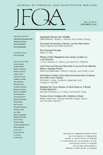
JOURNAL OF FINANCIAL AND QUANTITATIVE ANALYSIS
Empowering Insights in Finance and EconomicsJOURNAL OF FINANCIAL AND QUANTITATIVE ANALYSIS, published by Cambridge University Press, is a premier peer-reviewed journal that has been at the forefront of the finance and economics fields since its inception in 1966. With a notable impact factor reflecting its Q1 status in Accounting, Economics and Econometrics, and Finance for 2023, the journal is recognized for its substantial contributions to both theoretical and empirical research. Researchers and practitioners alike benefit from its comprehensive scope, addressing critical issues in financial analysis and quantitative methods. Although the journal does not currently offer open access, it remains widely accessible through institutional subscriptions. The editorial team is committed to fostering rigorous academic discussions that shape the future of finance and economics, making it an essential resource for academics, students, and industry professionals seeking to deepen their understanding of these vital disciplines. For more than five decades, this journal has continued to be an indispensable platform for disseminating influential research, thus solidifying its role as an essential cornerstone in the financial and quantitative analysis community.
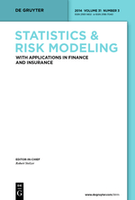
Statistics & Risk Modeling
Exploring innovative methodologies for risk modeling.Statistics & Risk Modeling is a distinguished journal published by WALTER DE GRUYTER GMBH, focusing on the intricate relationships between statistical methodologies and risk assessment techniques. With a strong academic foundation, the journal has been an influential platform in its field since its inception, converging contributions from 1982 to 2002 and again from 2011 to 2024. This journal is currently ranked in the Q3 category in both Modeling and Simulation and Statistics and Probability, reflecting its commitment to advancing knowledge and promoting robust research in statistics, probability, and uncertainty analysis. Although it offers a traditional subscription model, its significant contribution to the community is underscored by its increasing visibility in Scopus rankings, where it stands in the 44th percentile for Decision Sciences and Statistics. By comprehensively addressing contemporary issues in statistical theory and its practical applications, Statistics & Risk Modeling serves as an essential resource for researchers, professionals, and students aiming to deepen their understanding of statistical science and its implications in risk management.
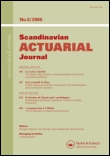
Scandinavian Actuarial Journal
Advancing statistical excellence since 1918.The Scandinavian Actuarial Journal, published by Taylor & Francis Ltd, stands as a pivotal resource in the fields of Economics, Econometrics, Statistics, and Probability, with a legacy dating back to 1918. This esteemed journal, headquartered in the United Kingdom, offers valuable insights and comprehensive research findings that contribute significantly to the actuarial and statistical communities. With its impressive 2023 quartile rankings—Q1 in both Statistics and Probability, and in Statistics, Probability and Uncertainty, as well as Q2 in Economics and Econometrics—this journal is recognized for its high-quality peer-reviewed content, making it indispensable for researchers, professionals, and students alike. Although it currently does not operate under an Open Access model, the journal ensures rigorous academic standards and broad visibility within its field. With a Scopus rank placing it in the top quartile of relevant categories, the Scandinavian Actuarial Journal is committed to advancing knowledge and fostering innovation in statistical methodologies and insights.
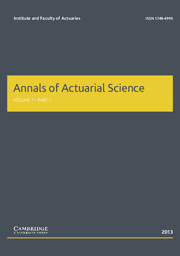
Annals of Actuarial Science
Exploring innovative insights in economics and statistics.Annals of Actuarial Science, published by Cambridge University Press, stands as a prominent academic journal in the fields of economics, statistics, and actuarial science. With an ISSN of 1748-4995, it features rigorous research aimed at advancing knowledge and practice in areas related to risk management, data analysis, and probability. The journal is recognized for its significant impact, holding a Q2 category ranking in both Economics and Econometrics and Statistics and Probability, along with notable positioning within Scopus rankings. Although it does not currently offer open access, its comprehensive selection of scholarly articles from 2010 to 2024 remains invaluable to researchers, professionals, and students alike, providing insights that drive the actuarial profession and enhance decision-making processes across various sectors. Positioned at the intersection of theoretical innovation and practical application, the Annals of Actuarial Science continues to shape the discourse and development of its disciplines.
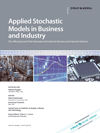
APPLIED STOCHASTIC MODELS IN BUSINESS AND INDUSTRY
Driving Innovation in Business Through Stochastic AnalysisApplied Stochastic Models in Business and Industry, published by Wiley, is a preeminent journal dedicated to advancing the field of stochastic modeling in various business and industry contexts. With an ISSN of 1524-1904 and an E-ISSN of 1526-4025, this journal serves as a vital platform for researchers and practitioners aiming to leverage stochastic techniques to address complex decision-making and operational challenges. The journal holds prestigious rankings, including Q2 in Business, Management and Accounting, and has converged years spanning from 1999 to 2024. It is distinguished by its wide scope, focusing on all aspects of modeling and simulation, as well as decision sciences and operations research. Although it does not operate as an open-access journal, its significant impact factor and Scopus rankings ensure that the valuable insights published within reach a broad audience. By fostering high-quality research and discourse, Applied Stochastic Models in Business and Industry plays a crucial role in driving innovation and excellence in its fields.
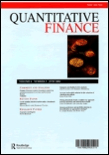
QUANTITATIVE FINANCE
Unveiling insights in the evolving world of finance.QUANTITATIVE FINANCE, published by Routledge Journals, Taylor & Francis Ltd, stands at the forefront of academic research in the dynamic fields of finance, economics, and econometrics. With a strong commitment to disseminating cutting-edge research, this esteemed journal, which has been published since 2001 and continues to thrive with an anticipated convergence until 2024, occupies a prestigious Q1 ranking in Economics, Econometrics, and Finance and a Q2 ranking in Finance as of 2023. It serves as an essential platform for interdisciplinary studies, aiming to bridge theoretical approaches and practical applications in quantitative methods. Researchers, professionals, and students are provided access to a wealth of high-quality articles that contribute to the ongoing discourse and advancements in these fields. As the journal continues to impact its community, QUANTITATIVE FINANCE remains an invaluable resource for those seeking to stay at the cutting edge of financial research and its applications globally.

JOURNAL OF FINANCIAL INTERMEDIATION
Navigating the complexities of financial institutions.JOURNAL OF FINANCIAL INTERMEDIATION, published by Academic Press Inc Elsevier Science, is a premier academic journal dedicated to the study of financial intermediation. First established in 1990, this esteemed journal has firmly positioned itself within the top quartile (Q1) of rankings in both Economics and Econometrics as well as Finance, reflecting its significant impact and relevance in the field. With an impressive Scopus ranking of #31 out of 317 in Finance and #74 out of 716 in Economics and Econometrics, it caters to a diverse audience, including researchers, professionals, and students interested in the intricate dynamics of financial markets and institutions. While the journal does not currently offer open access, it remains a vital resource for disseminating cutting-edge research and insights that drive innovation and inform policy-making in the financial sector. With a commitment to maintaining high academic standards, the JOURNAL OF FINANCIAL INTERMEDIATION continues to serve as an essential platform for advancing knowledge in financial theories and practices.
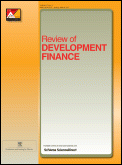
Review of Development Finance
Shaping Financial Strategies for Emerging EconomiesReview of Development Finance is a peer-reviewed academic journal dedicated to the exploration and promotion of innovative research in the fields of development finance, economics, and econometrics. Published by AFRICAGROWTH INST in South Africa, this journal serves as a vital platform for scholars and practitioners to share their insights on the financial mechanisms that drive development, particularly in emerging economies. Despite its current impact factor reflecting its nascent status within the lower quartiles (Q4) of its categories, Review of Development Finance aspires to contribute to the understanding and progression of finance as a tool for accelerating development from 2011 to 2024 and beyond. It encourages submissions that challenge conventional wisdom and provide empirical evidence supporting the role of finance in attaining sustainable growth. By fostering an open exchange of ideas amongst researchers, professionals, and students, this journal aims to enhance the discourse surrounding development finance and inspire impactful solutions to global economic challenges.

MANAGERIAL FINANCE
Unlocking Strategies for Contemporary Financial Challenges.MANAGERIAL FINANCE is a prestigious academic journal published by Emerald Group Publishing Ltd, focused on the areas of finance, management, and strategy. With an ISSN of 0307-4358 and an E-ISSN of 1758-7743, this journal has carved a niche for itself within the business and financial sectors, achieving a commendable Q2 category ranking across multiple domains, including Business, Management and Accounting, Finance, and Strategy and Management, as of 2023. The journal aims to provide a platform for insightful research and critical analysis while fostering an understanding of contemporary financial practices and theories. With its wide-ranging scope, it serves as a vital resource for researchers, professionals, and students alike, looking to stay abreast of the latest trends and challenges in managerial finance. The editorial board is committed to maintaining academic rigor, ensuring that articles published are of the highest quality and relevance to the field. By bridging the gap between theory and practice, MANAGERIAL FINANCE is an essential reference for anyone involved in financial decision-making and strategic management.

Journal of Financial Econometrics
Bridging theory and practice in financial econometrics.Journal of Financial Econometrics, published by Oxford University Press, stands as a leading academic journal in the fields of financial economics and econometrics. With an impressive impact factor and a ranking in the Q1 quartile for both Economics and Finance categories in 2023, this journal is recognized for its contribution to advancing theoretical and applied methodologies in financial econometric analysis. It publishes high-quality research that addresses critical issues in finance, aiming to foster a deeper understanding of the economic factors influencing financial markets and instruments. Researchers and practitioners alike benefit from its rigorous peer-reviewed articles, which are invaluable resources for both academic scholars and finance professionals. The journal’s content typically spans pioneering techniques in econometric modeling, empirical analysis of financial instruments, and innovative applications of econometric theory in real-world scenarios. Operating out of the United Kingdom, the journal continues to serve as a vital platform for disseminating significant research findings from 2005 to 2024, ensuring that the latest advancements in the field are accessible to its audience.